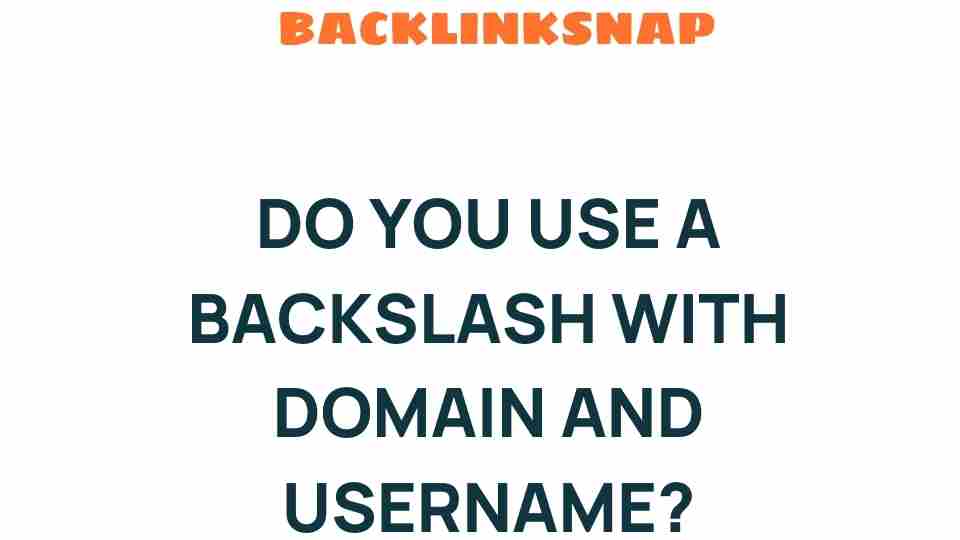Do You Use a Backslash with Domain and Username? Unlock the Mystery!
When navigating the world of internet terminology, it’s easy to get lost in the myriad of symbols, structures, and protocols that govern our digital communication. One common point of confusion is the use of a backslash in conjunction with a domain and username. In this article, we’ll explore the intricacies of URL structure, web protocols, and the role of the backslash in technical writing. So, let’s unlock this mystery and clarify when and how to use a backslash!
Understanding the Basics: What is a Backslash?
A backslash, denoted as “,” is a character found on keyboards primarily used in computer programming and file directory paths. While it may seem trivial, this small symbol carries significant weight in certain contexts, particularly in technical writing and computing.
In contrast to the forward slash (“/”), which is prevalent in URLs and web addresses, the backslash serves different purposes. It’s primarily employed in programming languages, file systems, and command-line interfaces. Therefore, understanding when to use a backslash is crucial for effective digital communication.
The Role of Domain and Username in URLs
The terms “domain” and “username” play pivotal roles in web protocols. A domain is a human-readable address that points to a specific IP address on the internet, making it easier for users to access websites. For instance, “example.com” is a domain name that directs users to a particular server.
A username, on the other hand, is typically associated with user accounts on various platforms and applications. It serves as an identifier for users, allowing them to log in and access personalized content. When combined with a domain, the username can create a structured URL that facilitates access to specific resources.
Do You Use a Backslash with Domain and Username?
The million-dollar question: do you use a backslash with domain and username? The answer is, it depends on the context. In standard web URLs, you **do not** use a backslash. Instead, you would use a forward slash. For example:
http://example.com/user/profileIn this example, the forward slashes separate different parts of the URL. The structure is clear: the domain is “example.com,” and the path to the resource is “/user/profile.” Using a backslash here would lead to confusion and potential errors, as web browsers are programmed to interpret URLs in a specific manner.
When to Use a Backslash
While backslashes are not used in standard URLs, they do have their place in computing:
- File Paths: In Windows operating systems, backslashes are used to denote directories. For instance,
C:UsersUsernameDocumentsis a valid file path. - Programming: Many programming languages utilize backslashes as escape characters, allowing you to include special characters in strings.
- Network Protocols: In certain contexts, backslashes may be used in network paths or when specifying UNC paths in Windows environments.
These examples showcase the importance of context in determining whether to use a backslash. In web protocols and URLs, stick to forward slashes for clarity and proper function.
Understanding the nuances of internet terminology is vital for anyone involved in technical writing or digital communication. Here are some key terms related to our topic:
- URL (Uniform Resource Locator): The complete address used to access a resource on the internet.
- HTTP (Hypertext Transfer Protocol): The protocol used for transferring web pages on the internet.
- IP Address: A unique identifier assigned to each device connected to a network.
- Domain Name System (DNS): The system that translates domain names into IP addresses.
Familiarizing yourself with these terms can greatly enhance your understanding of digital communication and help you avoid common pitfalls when writing technical content.
Common Mistakes in URL Structure
As we delve deeper into URL structure, it’s essential to recognize some common mistakes that users frequently make:
- Using a backslash when a forward slash is required.
- Omitting “http://” or “https://” at the beginning of the URL.
- Misplacing or omitting elements within the URL, leading to broken links.
- Failing to understand the difference between subdomains and paths.
By avoiding these mistakes, you can improve your digital communication and navigation skills, making your online experiences smoother and more efficient.
FAQs About Backslashes, Domains, and Usernames
1. Should I use a backslash in a web address?
No, web addresses should always use forward slashes (/) to separate different components of the URL.
2. What is the difference between a domain and a username?
A domain is the address of a website, whereas a username is an identifier for a user account on a platform or service.
3. In what contexts is a backslash appropriate?
Backslashes are commonly used in file paths on Windows operating systems and in programming languages as escape characters.
4. Can using a backslash in a URL cause errors?
Yes, using a backslash in a URL can lead to errors, as web browsers expect forward slashes to correctly interpret the URL structure.
5. What are some common URL mistakes to avoid?
Common mistakes include using backslashes instead of forward slashes, omitting the protocol (http://), and misplacing URL elements.
6. How can I improve my understanding of internet terminology?
Familiarize yourself with key terms, read technical writing, and practice creating URLs to enhance your knowledge.
Conclusion
In conclusion, understanding the use of a backslash with domains and usernames is crucial for effective digital communication. By recognizing the differences between backslashes and forward slashes, as well as the roles of domains and usernames in URL structures, you can navigate the complexities of the internet with confidence. Remember, while backslashes have their place in programming and file paths, they do not belong in web addresses. Keep this guide handy, and you’ll be well on your way to mastering internet terminology!
For more insights on technical writing and digital communication, feel free to check out this resource. And if you’re looking to improve your understanding of URL structures, visit this helpful website.
This article is in the category Digital Marketing and created by BacklinkSnap Team




